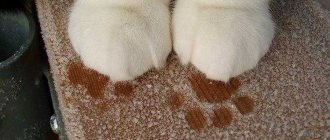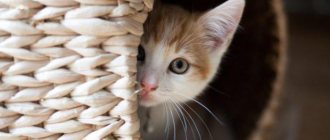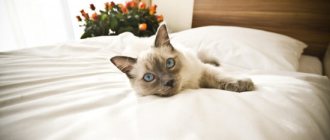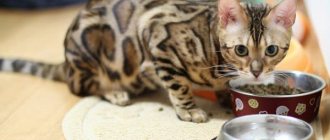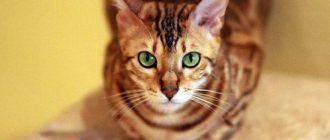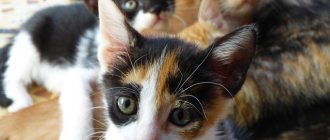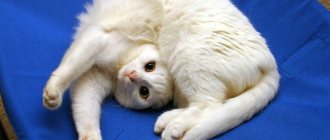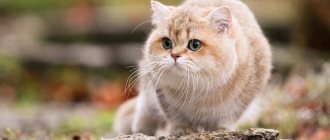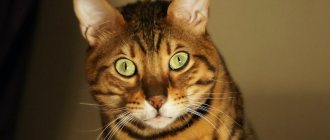Physical Characteristics of the Bengal Cat
The Bengal breed is the result of deliberate crossbreeding between the exotic Asian leopard cat and domestic cats. The first Bengal cat happened quite by accident when the owner of a leopard cat thought she looked lonely, put his short-haired male in a pen with her to interact with, and the pair ended up mating.
Many obstacles were overcome to develop the Bengal breed as we know it today, including producing cats with reliable temperaments and functional reproductive systems. Since modern Bengal cats are the product of Bengal breeding only, their personalities are quite predictable and they make wonderful pets.
The Bengal is a sight to behold. At first glance, they look like wild cats with intricately patterned fur, much like leopards. They are sleek and muscular, heavy-boned, yet graceful and agile.
Bengal cat
The Bengal cat's fur comes in many patterns, each of which should have very contrasting markings. The spots on the coat mimic the classic leopard spots, while the occasional merle pattern comes from the domestic tabby gene. Bengal cats may also have a "shine gene" that gives the tip of their fur a shiny quality.
Métis
There are significant features in breeding the Bengal cat breed. They currently do not have officially recognized mestizos due to the ban of felinological communities on crossing with other species. There are also few unofficial “derivatives” based on Bengals; sometimes it is difficult to recognize and distinguish them from the real ones. The recently bred cashmere (or silk) Bengal with long hair, which has become more and more loyal to specialists over the years, has shown that there is a “dormant” gene for long hair in the gene pool of the hybrid. A special text is dedicated to the mixed breeds of the Bengal cat.
Bengal cat personality
Bengal cats are confident but obedient. They are a people-oriented breed and enjoy time with their owners. They form close and loyal bonds with their two-legged family members, with much love for the entire family.
The Bengal cat is playful and curious, and can often be found following its owners around the house in search of new adventures. Daily play sessions are important because Bengal cats need exercise to exercise both their body and mind. Bengals also love to climb, so providing them with vertical obstacles in the house is a must.
Bengals are a very intelligent breed and can be taught to pick up a toy or sit on command. Many Bengals can be trained to use human litter, partly due to the habit their leopard cat ancestors developed of urinating in bodies of water to dilute the smell. Most Bengal cats love water too. They might jump on the counter to help you wash the dishes or join you in the shower.
The Bengal cat is unique in the cat show world in that the breed standard includes a description of the cat's ideal temperament. If a cat shows any signs of a problem, it will be disqualified to prevent temperament problems in the breed.
Bengal cat
Bengal cats love to hunt and will look for opportunities to tap into this natural instinct. They love to hunt small animals such as birds, but will also hunt for prey in the water. The Asian leopard is known for its fishing abilities, and Bengal cats often seek out water as part of their instinctive drive to catch fish for food.
The Bengal cat often swims or plays in the water, which is the complete opposite of regular house cats. It is important that potential owners understand that the Bengal cat is definitely a combination of a wild and domestic cat.
While they certainly carry the traits and personality of domestic cats, they strongly exhibit their wild ancestry thanks to their high energy needs and innate drive to hunt. Failure to do this may result in a Bengal cat developing with personality problems.
Diet
Typically, wild Bengal cats feed on small game, such as mice, rats, hamsters, rabbits, squirrels or birds.
During periods of hunger, the animal can hunt various reptiles, insects, and small animals. Sometimes they can fish, but most often they hunt on land, since their color helps them in such conditions.
If a wild animal finds the eggs of other animals, then it will eat them too.
For domesticated wild Bengal cats, you need to choose a special diet. It must be balanced and contain all the necessary vitamins, minerals, and macroelements.
The animal can be fed with special balanced feed. But it is very important not to focus on them, but to give them more meat and other natural foods.
Industrial feed
The digestion of Bengals is quite difficult to tolerate a change in diet. Buy good, expensive industrial food. It is completely unreasonable to buy a pet for a lot of money and then spoil its health with bad food.
The food must be of the highest quality. It is best to ask the breeder what food you can feed your little leopard. It is important that a cat on such a diet always has fresh water. It is best to buy electric bowls in which the water is constantly renewed. This will resemble a pond or stream and will inspire more confidence.
Natural food
But it is best to feed the animal with natural food. Many people believe that if you feed a predator meat, it will become even more wild. This is wrong. Such an animal really needs raw meat, since only through it can the cat receive the necessary elements.
The meat can be anything: chicken, beef, fish. You can add porridge (without milk) and boiled vegetables to your diet.
Wild bengal in an aviary
Common Health Problems for the Bengal Cat
Feline infectious peritonitis (FIP)
FIP is a viral disease caused by feline coronavirus. In some cats, an aggressive inflammatory response creates clinical signs. FIP is a complex disease with no reliable test or treatment. Signs are usually vague and include fever, weight loss with decreased appetite, and a pot-bellied appearance.
Entropion of the century
Entropion is a condition that affects the eyelids of some Bengals when the eyelid rolls inward toward the cornea. It usually affects the lower eyelid, but can sometimes affect both. Hair on the inner eyelid irritates the surface of the eye, causing discomfort and corneal ulceration, and requires surgery to correct the affected eyelid.
Progressive retinal atrophy
The retina is responsible for transmitting light to the brain, where it is interpreted as an image. When progressive retinal atrophy occurs, retinal cells begin to break down, eventually causing blindness.
Feline hypertrophic cardiomyopathy
Feline cardiomyopathy is the most common heart disease affecting cats. With it, the walls of the cardiac muscle thicken, making it difficult for the heart to work effectively. Cardiomyopathy can lead to congestive heart failure, fatal arrhythmias and blood clots, and sudden death can occur without any previous signs of heart disease.
The average lifespan of a Bengal cat is 14-16 years, which is similar to the lifespan of ordinary felines. Bengal cats are generally healthy. However, they are more susceptible to certain diseases due to Bengal cat genetics. If you are planning to buy a Bengal cat kitten, be sure to check for a health passport, and also meet your kitten’s parents, make sure they are healthy. Bengal kittens are very cute, so it can be difficult to recognize a sick kitten.
A Bengal cat may have other health problems:
- Feline hyperesthesia syndrome
- Hip dysplasia
- Patella luxation
- Pyruvate kinase deficiency.
Basic information
| Breed name: | Bengal cat |
| Country of origin: | Southeast Asia |
| Period of appearance of the breed: | 1961 |
| Type: | Home |
| Average weight: | 2.5 - 7 kg |
| Height at withers: | 15-30 cm |
| EMS code: | BEN |
| Average life expectancy: | 12 – 25 years |
| Prices for kittens: | 1000 — 2500 $ |
| The most popular nicknames: |
Caring for a Bengal cat
The Bengal cat has short hair and needs to be brushed with a soft brush weekly to reduce hair loss. Bengals, like all cats, are fastidious groomers and will keep themselves clean. Bathing is only necessary if your curious Bengal has found an adventure too big to clean on his own.
The Bengal cat is an energetic, playful breed and needs a lot of interaction every day to engage its body and mind. Make time to play with your pet or train your Bengal to walk on a cat-sized treadmill or exercise wheel to release energy.
The Bengal cat is the ideal cat for you if:
- You have time to play with her every day.
- You want your cat to be like a dog in temperament.
- You spend enough time at home to develop a close bond with your cat.
- You are the only owner looking for a friendly relationship.
- You have a family without children - for example, when the children have already grown up and started their own families and do not live with you.
- You have a child, but he is already quite old - for example, a teenager.
Temperament of a Bengal cat
The Bengal cat cannot be called gentle. They are athletes: agile and graceful, with a strong, muscular body, as befits a cat that looks like they belong in the jungle.
Despite their wild appearance, Bengal cats are actually quite affectionate with their human families. However, they also have high energy and a fun-loving playfulness. They want to stay active and need a home that can match their energy.
If you can meet your Bengal cat's exercise needs, you will have a smart, loving cat that can keep you on your toes.
When a Bengal gets bored, he is able to take things apart to see how they work and open drawers and cabinets to see what interesting toys or food might be available to him.
The Bengal cat loves its owners and will do anything to get attention from them. If he realizes that you don't like what he's doing—like jumping on the kitchen counter—he'll start doing it all the time because it will get your attention and force you to interact with him. He also likes to take things and hide them. Put your jewelry away where he can't reach it.
Every cat is different, but most Bengals get along with other pets, including dogs. They are best suited for homes with older children who will enjoy playing with them, but if they have an escape route from the little ones they will take it.
The Bengal cat is a cat that needs a lot of vertical territory. Bengals love to climb, the higher the better. Provide them with tall cat trees and window sills. They also love to play in the water. Don't be surprised if your Bengal cat wants to join you in the shower or bath. You can install a motion-sensing faucet in your bathroom or kitchen so that it can turn the water on and off automatically. Your Bengal cat will appreciate it if you have a drinking fountain because he loves water.
Bengals are also very intelligent and enjoy the attention that comes with training. Challenge their brains and keep them interested in life by teaching them tricks and games and providing them with interactive or puzzle toys, and reward them with treats when they learn to manipulate them.
Always choose a kitten from a breeder who raises Bengal kittens in-house and handles them from an early age. Get to know at least one, and ideally both, parents so they have a good temperament.
If you want to buy a Bengal cat
Some cat breeds tend to be independent and aloof, even if bred by the same person since they were kittens, others are closely bonded to one person and indifferent to everyone else, but Bengals are loving towards all family members.
Breed isn't the only factor that influences bonding levels; cats that are raised in a home with others feel more comfortable with people and bond more easily.
If you're going to be sharing your home with a cat, you're going to have to deal with some level of cat hair on your clothes and in your home. However, shedding varies among breeds. If you are a tidy owner, you will need to choose a breed that is short-haired or relax your criteria for cleanliness.
Due to poor breeding practices, some breeds are susceptible to certain genetic health problems. This doesn't mean that every cat of this breed will develop diseases - it just means that they are at increased risk. If you're only looking for purebred cats or kittens, it's a good idea to find out what genetic diseases are common in the breed you're interested in.
Bengal kitten
Some cats are the eternal Bengal kittens - full of energy and mischief - while others are more serious and calm. While a playful Bengal kitten sounds appealing, consider how many games of chasing a mouse toy you want to play every day, and whether you have children or other animals who can act as playmates.
Some breeds are louder than others. When choosing a breed, think about how the cat meows and how often. If constant “talking” drives you crazy, think about it: a kitten “talks” no less often than a human.
Some breeds require very little grooming, while others require regular brushing to stay clean and healthy. Consider whether you have the time and patience for a cat that needs daily brushing.
Some cat breeds are considered smarter than others. But all cats, if deprived of the mental stimulation they need, will keep themselves busy. Interactive cat toys are a good way to exercise your cat and keep her out of trouble.
Upbringing. Training
The independent nature of Bengals does not mean that they will not obey. Using short, strict “no” orders in parallel with a gentle pinch on the neck that is understandable to the animal (this is what cat mothers do when raising kittens), you can achieve compliance with order. The easiest way to reach a consensus on following the rules is based on the instincts and desires of the pet itself. To do this, at the first “observational” stage you need to notice how the cat behaves. Habits, preferences, behavioral characteristics are then used in choosing educational methods.
More than other cats, Bengal cats will not tolerate violence, so pedagogy a priori involves encouragement, affection, and is built on complete trust. Educational processes must begin at a very tender age - read the article “Upbringing and training” about this.
History of the Bengal cat
People have always been attracted to the beauty and independence of wild cats and have even attempted to keep wild cats such as ocelots, cheetahs and lions, usually with little success and much heartbreak. The Bengal cat was developed to try to satisfy this desire for a wild appearance in a safe way by crossing small wild Asian leopard cats and domestic shorthairs. Jean S. Mill began the Bengal breeding program in 1963, and Bengals today are descended from cats she bred in the early 1980s.
The International Cat Association recognized Bengals in 1991. The breed is not recognized by the Cat Fanciers' Association.
History of the discovery of the species
The wild Bengal cat is a small predator that lives in the territories of East and South Asia.
But she can only be found there. Its distribution area is wide. This predator is a direct relative of the Asian leopard. Everywhere it is called the Asian leopard. But in Russian sources it is often referred to as a Bengal and is often confused with a domesticated breed. Bengals that still live in the wild are in danger. Every year they are killed by local residents because of their beautiful, soft fur coat. Therefore, this animal is listed in the International Red Book.
Wild bengal in habitat
Breed standard
The Bengal cat breed has its own special standard. The main goal of breeders is nothing less than to remain as true as possible to the wild appearance of the leopard cat, but with the character of a domestic animal.
Bengal cat breed standard
1. Color : All variants of "brown spotted tabby" are acceptable, although in most cases a high level of "rufinism" (orange tones) is desirable. The base color of the coat can be cream, beige, grayish, golden or rufus. The spots may be black or brown, or, like leopard spots, they may also contain a chocolate tint. The chin, whisker area, belly and between the hind legs should be a color such as white or any other light tone. But on the sides and back the coat should be darker to enhance the contrast between these areas. The lining around the eyes and nose should be black, and the mucous membranes should be brick red in color. The pads and tip of the tail should be black.
2. Head : should be wedge shaped. Wide and rounded, longer than wider. The jaws should be wide enough. The size should be slightly smaller in proportion to the body.
3. Profile : forehead slightly curved, concave. The nose is wide and large, with slightly swollen whisker pads. High and prominent cheekbones.
4. Ears : small to medium in size, short and wide, rounded. They are located symmetrically along the contour of the face. Several horizontal light colored markings on the back of the ears are accepted. Long hair at the end of the ear (tassels) is undesirable.
5. Eyes . Oval in shape, although may be slightly almond shaped. Large, well separated from the base of the ears. The color may be gold, green or blue, but not yellow. Only one variety of Bengal, the “snow leopard,” has blue eyes.
6. Neck : Thick and muscular (more in males), slightly larger in proportion to the head and slightly longer in proportion to the body.
7. Body : long and strong, strong, but not like the “oriental” or “foreign” type. The body is large, although not as large as the largest domestic cat, and the bones are quite strong, far from thin. Very muscular, especially Bengal cats, which is one of the most outstanding features.
8. Legs of a Bengal cat : medium in size, the hind legs are slightly longer than the front. A thick and strong skeleton, not delicate in any way. Very muscular, like the body.
9. Paws : Large in size, rounded and black paws.
10. Bengal Tail : Thick, slightly reduced to the end, the fairy tip is always rounded and always black. The length is medium and the thickness is medium to large.
11. Wool: short. Bengal kittens are allowed a slightly longer coat, for example when they are in the maturing stage. Thick, shiny and incredibly soft wool.
12. How points are added and subtracted when evaluating the Bengal breed.
Points are awarded if the standard is met.
- Presence and consistency of stains: 30 points.
- Color: 10 points.
- Obedience: 10 points.
- Ears: 10 points.
- Bengal eyes: 5 points.
- Neck: 5 points.
- Body: 10 points.
- Legs: 5 points.
- Paws: 5 points.
- Wool: 10 points.
Points will be deducted if:
- Spots on the body that unite to form vertical stripes, this coloration is known as "striped mackerel".
- medallion, a button of gray hair on the throat area.
- The color of the tip of the tail is different from black,
- There are no spots in the abdominal area,
- The Bengal cat has pink paws.
So the standard of the Bengal cat breed is quite harsh.
Mr. Cat recommends: description, characteristics, habitat
In nature, wild cats are found on islands in Indonesia, the Amur region, and Asia, where they are represented by numerous subspecies. They adapt well to different conditions: forests, plains, taiga. They prefer places near water sources, but away from human settlements. Avoid desert areas without vegetation. They are found in the mountains at an altitude of 3 thousand m above sea level, on rocks and rocky outcrops.
The color and pattern on it changes depending on the habitat. The main color tone is shades from yellow to gray-brown. The chin, chest, and belly are almost white, and the end of the tail is black. Dark spots are scattered throughout the body: circles, smears, or collected in rosettes. The drawing can stand out strongly against the background or be almost invisible.
The length of the elegant strong body is 75-100 cm, the tail is almost half, the height is 39-41 cm. Weight is 3.8-7 kg. Males are larger than females. The coat is thick, soft, and short. The head is small in size with a narrow muzzle. The ears are rounded without tufts. The eyes are brown, large and round. The tail looks like a carrot.
They live in nature for 12-15 years. The voice resembles that of a domestic cat.
How to care for a Bengal cat
First of all, Bengal cats are quite intelligent and entertaining. Secondly, they are surprisingly healthy and require little, if any, care. Lastly, they are actually more canine in nature than other domestic breeds. Bengals will walk on a leash, love to exercise, love to take baths and play games of chance!
The beauty of the domestic Bengal cat is simply undeniable. Continue reading to learn more about this breed and how to care for a Bengal cat.
Make sure you get your Bengal cat from a reputable breeder.
Bengal cats have such unique characteristics, both in appearance and behavior, that you will want to get a Bengal cat from a reputable breeder. When a Bengal cat's coat is not suitable for show quality, some Bengal kittens may be available at a greatly reduced price.
If you don't intend to show your cat, you can still enjoy the benefits of a Bengal's personality, as long as the Bengal's remaining traits are of high quality.
Bengal cat on the hunt
Be sure to do your homework before purchasing a kitten to ensure that you only purchase from a reputable Bengal cat breeder. This person or organization will provide a written health guarantee, can demonstrate optimal kennel conditions, and must belong to a professional association.
As a rule, you can determine by the condition of the premises where the Bengal cat and kittens are kept and the character of the breeder whether he likes cats and whether he wants to get kittens of the highest quality. An even better idea is to check if there are any Bengal cat rescue organizations in the area. Volunteers are usually quite knowledgeable about the breed. Get added satisfaction knowing you've adopted a Bengal cat in need of rescue.
Ear care
You know that even though your Bengal cat loves to bathe, water is not good for her ears. Try to dry your cat's ears immediately after bathing with a warm towel. Blot with a cotton pad.
Eye care
It is necessary to take your cat to the veterinarian once a year due to possible eye problems in Bengal cats. But if your cat has a clear look and there is no leakage from her eyes, then you don’t need to do anything.
How to wash a Bengal cat
How to clean a Bengal cat or how to wash it. How often should this be done? If you take your cat for a walk outside, then you need to wash her paws after going outside, see if her fur is clean, and if your cat has picked up unnecessary insects. In general, it is enough to wash a cat once a month, especially if it sits at home. Bengals usually lick their lips and look very neat.
Puberty and reproduction
Puberty in a wild Bengal cat occurs at 1.5 years. To raise offspring, these cats unite in pairs. The female looks for a safe place for the den and arranges it. In the southern regions, mating is possible at any time, in cold regions - in the spring, when it gets warmer and conditions become favorable for raising kittens.
The gestation period is on average 66 days, after which 2-3 kittens are born, less often - 4. They begin to see at 10 days, and within a month they already leave the shelter and begin to get acquainted with the surroundings. They are fed milk; from three weeks of age they are accustomed to eating meat. Both parents are involved in raising the younger generation. Kittens leave them 10 months after birth.
What makes Bengal cats different?
Compared to regular house cats, Bengal cats are different in that you must approach caring for this breed in a unique way:
Physiology: Bengal cats are “made” differently from their other feline relatives. The shape of their face and ears has an exotic appearance. They are generally stronger and more athletic than other cat breeds.
Water Love : A cat who loves to play in the water or even swim? Incredible, right? However, Bengal cats are famous for their love of water. They might even jump into the bath or shower with you!
Activity Level: These cats are high energy! Plus they are very bright and attractive. Forget what you think about lazy cats lazing around all day. If you're thinking about getting a Bengal cat, be sure to plan to keep them entertained to prevent them from becoming bored and potentially destructive!
Loyalty: This is a trait of the Bengal cat. They are very affectionate, friendly and loyal. Not an ordinary cat that walks on its own. A Bengal will greet you and interact with you just like a dog.
Trainability : Bengals are highly trainable because they are intelligent, agile and loyal. Just watch the video about the Bengal cat. Can you believe that a cat can be taught to roll over, to walk on its hind legs next to its owner?
Appearance : One look at a Bengal and you know you are looking at an exotic cat breed.
If you want a Bengal cat to live in your home, then you want to insure yourself against boredom and sadness. Bengal cats are loyal and cheerful friends. Now you know everything about this cat breed to make a decision.
Features of behavior
Bengal wild cats are loners by nature. They unite in pairs only for procreation. Active life begins at dusk and lasts throughout the night. They spend the day in hiding. Hollows or roots of trees, caves, and holes abandoned by other animals serve as lairs. Some individuals can hunt during the day, but this is extremely rare.
They climb and swim well. They move quickly through trees thanks to their sharp claws. They set up an ambush on hanging branches and rush at their prey from above. Their body color helps them camouflage well. They mark their territory with urine and excrement. They can relieve their natural needs in water. This helps them hide their presence from potential enemies.
